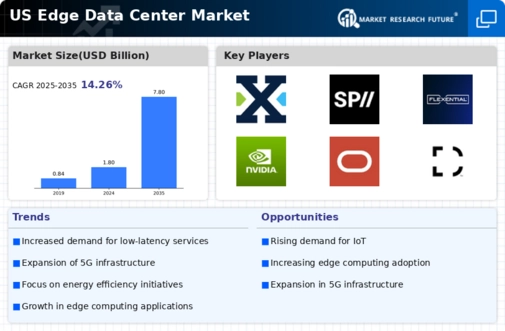The US Edge Data Center Market is rapidly evolving, driven by increasing demand for reduced latency and enhanced processing capabilities close to the end user. This shift to edge computing enables service providers to offer faster, more efficient solutions by distributing computing resources and data storage across geographically dispersed facilities. In this dynamic landscape, various players are positioning themselves to cater to the demands of businesses seeking seamless connectivity and real-time data processing. Competition in this sector is characterized by companies investing in cutting-edge technologies, strategic partnerships, and expanded geographic footprints to capture a larger share of the market.
Understanding the strengths, weaknesses, and unique offerings of these competitors is crucial for stakeholders looking to navigate the complexities of the edge data center arena.Interxion stands out in the US Edge Data Center Market due to its solid market presence and portfolio of strengths that differentiates it from competitors. A strong commitment to reliability and performance is evident through its extensive network infrastructure, designed to facilitate high connectivity and support for various industries. The company emphasizes robust security standards and compliance, which is increasingly important for enterprises handling sensitive data.
Furthermore, Interxion's strategic positioning in key urban areas enhances its appeal to businesses that require not just edge computing capabilities but also the associated high-speed connectivity to major internet exchanges. The continuous enhancement of its data center facilities ensures that stakeholders are equipped with the resources necessary to meet the ever-evolving demands of the digital age, making Interxion a formidable player in the market. StackPath is another notable provider in the US Edge Data Center Market, focusing on delivering integrated edge computing solutions designed to optimize internet performance.
The company specializes in edge cloud services, including content delivery networks (CDN), web application firewalls, and secure edge services that enable businesses to improve their digital experiences effectively. StackPath has established a significant presence in metropolitan areas across the United States, enhancing its capability to serve varied customer needs. The company's strengths lie in its comprehensive security features and commitment to providing low-latency services, making it an attractive choice for online content providers and enterprises alike.
Additionally, StackPath has been active in implementing strategic mergers and acquisitions, which have bolstered its service offerings and broadened its technical capabilities within the edge data center ecosystem. This strategic growth underscores StackPath's dedication to maintaining a competitive edge in a market that continuously evolves alongside technological advancements.






















